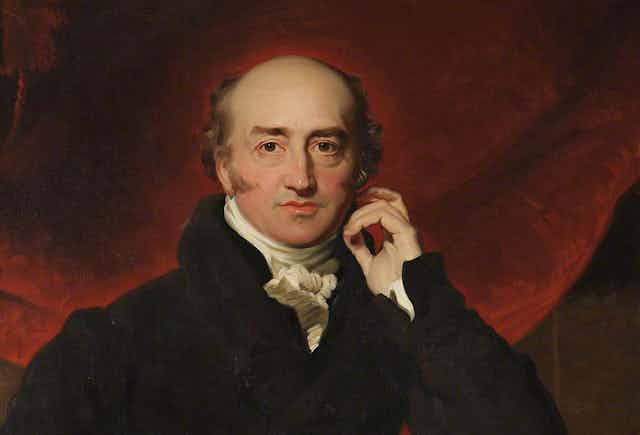Liz Truss announced her resignation on October 20 2022, 44 days after taking office. The departure makes her the UK’s shortest-serving prime minister. But who did she replace to earn this undesirable accolade?
The previous holder of this title was George Canning, who lasted more than twice as long as Truss. He died in office after a premiership of 119 days. Known by many as the “lost leader” because of his short tenure, Canning still left his mark on British political history. He is one of only four prime ministers to have a statue in Parliament Square, the others being Benjamin Disraeli, David Lloyd George and Winston Churchill. While Canning’s time as prime minister was short, his distinguished political career spanned 34 years, from securing a seat in the Commons in 1793 to his death in 1827.
Canning was a marmite character, beloved by his political inner circle but viewed with suspicion and distrust by many outside of it. He was seen as overly ambitious, arrogant and not at ease – as suspicious of others as they were of him. Some think this was partly due to his humble upbringing. He was the only prime minister to sit in the House of Commons in the first half of the 19th century, as most others came from the Lords.
Brought up in a Whig family, Canning was elected for the Tories in 1793 under the guidance of Tory prime minister William Pitt the Younger. Both historians and his contemporaries described their relationship as like father and son.
After his own ambitious but economically unsuccessful father died on young George’s first birthday, Canning was adopted at the age of six by his aunt and uncle. His mother, Mary Ann, became an actress after his father’s death to provide for the family, and from then on was a constant source of shame for Canning. He kept their relationship private, even his own wife and children only saw her once or twice in her lifetime.
She was the focus of many political jibes aimed at Canning during his career. In an 1827 parliamentary debate following the resignation of Lord Liverpool as prime minister, Lord Grey (of Earl Grey tea fame) said that the son of an actress is “incapacitated de facto for the premiership of England”. The detailed correspondence between Canning and his mother highly suggest that this relationship is the source of Canning’s guarded nature and ambitious drive.
Were Canning and Truss similar?
Beyond its brevity, Canning’s political career shows many similarities to that of Truss. Like Truss, Canning was foreign secretary, holding the position from 1807-1809 and again from 1822-1827, a role in which many believed he excelled. He had a particularly notable triumph in September 1807, when he arranged the confiscation of the Danish fleet at Copenhagen, thus disrupting Napoleon’s plans for expansion during the Napoleonic Wars.
Canning similarly came into power under a period of Tory infighting. By 1827, the Tory party was largely split into two factions. The Duke of Wellington and Sir Robert Peel led the more right-wing side of the party, known as the “Ultras”, while Canning and his followers were known as the more moderate Canningites. When Canning was asked to form a government in April 1827, he struggled to form a cabinet after the immediate resignations in protest of Wellington, Peel and other Tory Ultras. Canning did manage to form a shaky government in April 1827, turning to some Whig colleagues to fill the vacancies.
Read more: Liz Truss resigns: who is in and who is out in the race to replace her?

However, unlike Truss, Canning had a reputation of being a skilled orator, with his “quicksilver brilliance in public debate” well regarded across both Houses. His death, 119 days into his premiership, was put down to stress, worry and anxiety by his contemporaries. But it was inflammation of the lungs (regarded as pneumonia or sometimes tuberculosis) that was registered as the cause of death. His popularity was demonstrated by the crowds that turned up to his funeral on August 16 1827 at Westminster Abbey, where he was buried and a statue to his memory was erected in 1832.
Reactions to his death were as mixed as those about him when he was alive. Contemporary comments ranged from Whig Sir James Mackintosh’s view that a lost statesman who had yet to reach his greatest heights. Austrian Chancellor Klemens von Metternich said that Canning was “a whole revolution in himself alone”. The most spiteful appears to have been the Duke of Bedford’s delight at the death of someone capable of “infinite evil”. Exactly what prompted Bedford’s comment is unclear, other than his great dislike of Canning. Even in death, Canning still had his bitter opponents.
Whether or not Canning would have transformed British politics as prime minister is still a source of debate among political historians. So, when you are asked the inevitable trivia question “Who did Liz Truss replace as the shortest serving prime minister?”, know that she beat a statesman remembered as “one of the most singular and remarkable” of the first half of the 19th century, by fans and critics alike.

